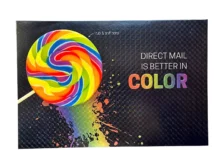 The use of foil and other multisensory packaging effects has become more and more common in a crowded marketplace competing for customer attention. Metallic foils are often a simple, yet effective, way to enhance a product’s aesthetic and set it apart. Evolving out of the hot stamping process, the use of cold foil has become more and more common in the last few years. Despite its popularity, there are still areas of confusion when it comes to the cold foil process.
The use of foil and other multisensory packaging effects has become more and more common in a crowded marketplace competing for customer attention. Metallic foils are often a simple, yet effective, way to enhance a product’s aesthetic and set it apart. Evolving out of the hot stamping process, the use of cold foil has become more and more common in the last few years. Despite its popularity, there are still areas of confusion when it comes to the cold foil process.
PostPress sat down with Eagle Systems President Mike King to discuss some of the most common questions finishers and printers have regarding the cold foil process. Well versed in the design and manufacture of foil stamping and print enhancement equipment, Eagle Systems has encountered many of the issues experienced by those switching to cold foil. King offered the following insights for those looking to expand their knowledge of cold foil and its benefits.
Is cold foil replacing hot foil stamping?
Yes and no. I started building hot stamping machines with my father more than 40 years ago. That’s where my background comes from. However, over the past 11 years, my focus has shifted to involve more cold foil machinery due to market trends and customer demands.
Hot foil stamping is still a better fit for many foil applications, but cold foil has come a long way in quality and feasibility. It can be used for many applications. Most cold foil retrofits are on 40-inch sheet-fed units, and cold foil is most effective for shorter run work. In fact, most jobs around the world are less than 10,000 sheets. This is where cold foil really shines with economics. Savings is extreme in these cases.
What are the main benefits of cold foil?
Because the foiling and printing can be done in a single process, cold foil can lead to significant savings when it comes to time and money: Time because it is one pass on a press and money because of no tooling costs (dies) that are needed. For example, a job that normally would take two separate machines – one machine for the printing and one to apply the foil – and take an additional eight hours of press time, can be accomplished in about 20 additional minutes with cold foil.
In addition, cold foiling can be an excellent alternative to printing on foil laminated board. Cold foil does not require special UV inks and dryers that can add costs to the process. The areas of the design that do not include a metallic finish can be reversed out on the sheet, so white opaque ink does not need to be applied in a separate station on the printing press, where sometimes even two hits are needed to cover the metallic laminated board.
What are the cost differences of cold foil vs. hot foil?
With the increased interest in cold foil today, the foil itself is more freely available, while the cost is similar to that of hot foil. However, cold foiling does consume more foil product if the entire full web of the foil is used. Cold foil equipment today can have up to eight narrow webs. The operator can select the foil width required according to the area to be foiled, which can save a great deal of overall foil usage.
The design of the piece or sheet will determine which method is best and which method will be the least costly. If there is only a small area of metallic foil on the design, then hot stamping may be the best choice. If there is a large area of metallic and several foil colors specified, cold foil is probably best.
Like hot foiling, cold foil has developed its own market. Printers and finishers offering cold foil to their clients can make it so that those clients only work with cold foil in their designs.
How is cold foil applied?
Cold foil is like a sticky offset ink, and it is applied using a conventional printing plate and blanket in the areas where the metallic foil is needed to adhere. Essentially, it works like a printable glue on the sheet. Today, there are a number of cold foil adhesive suppliers.
Does adding cold foil slow down the printing press?
Utilizing the right foil, adhesive and cold foil unit, a printing press can run at full-press speeds for many applications. Cold foil does not slow down the printing press process.
Why has the cold foil process taken so long to catch on in the offset sheet-fed market?
A few years back, cold foiling was still considered a risky process. Many finishers had bad experiences early on, which may have contributed to the slower acceptance of the process. However, developments in foils, adhesives, blankets, etc., have helped mature the process, and today cold foiling is widely accepted and becoming more and more common.
Where have you seen the most growth in cold foiling?
I would say packaging where brand owners need differentiation in areas such as cosmetic, pharmaceutical, healthcare and confectionery. We are even seeing a demand in food products as well and, of course, the tobacco and label industries are full of potential. Interest also has started with those producing magazines and catalogs, since this type of foiling does not leave an impression in the paper, allowing for perfect printing on both sides of the sheet.
Mike King is president/CEO of Eagle Systems, a leader in the design and manufacturing of cold foil, hot foil stamping and Cast and Cure print enhancement equipment. For more information visit www.thefoilexperts.com.




